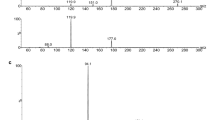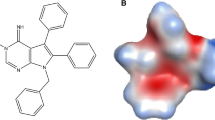Abstract
Objectives: To characterize the enzymes responsible for and metabolites produced from the metabolism of halomon, a halogenated monoterpene that is isolated from the red algae Portieria hornemanii and has in vitro activity in the NCI screen against brain, renal, and colon cancer cell lines. Materials and methods: Mouse and human liver fractions, prepared by homogenization and differential centrifugation, were incubated with halomon, extracted with toluene, and analyzed by gas chromatography. Results: In the presence of NADPH, mouse-liver 9,000-g supernatant (S9) fractions metabolized halomon, but boiled S9 fractions did not. NADH could not substitute for NADPH. Further separation of murine hepatic S9 fractions produced a microsomal fraction that contained all of the halomon-metabolizing activity; cytosol had none. Carbon monoxide reduced murine hepatic microsomal metabolism of halomon, whereas an anaerobic, N2 environment greatly accelerated the disappearance of halomon. Human hepatic microsomes metabolized halomon and required NADPH to do so. Carbon monoxide completely inhibited human hepatic microsomal metabolism of halomon. Unlike murine hepatic microsomal metabolism of halomon, anaerobic conditions did not enhance the metabolism of halomon by human hepatic microsomes. Neither 100 μM diethyldithiocarbamate, 1 μM quinidine, 100 μM ciprofloxacin, 3 μM ketoconazole, nor 100 μM sulfinpyrazone inhibited the metabolism of halomon by human hepatic microsomes. Both murine and human hepatic microsomes produced a metabolite of halomon. The mass spectrum of this metabolite indicated the loss of one chlorine atom and one bromine atom. Conclusions: Halomon is metabolized by mouse and human hepatic cytochrome P-450 enzymes, the identities of which remain unknown. Hepatic metabolism of halomon is very consistent with the concentrations of halomon measured in mouse tissues and urine after i.v. administration of the drug.
Similar content being viewed by others
Author information
Authors and Affiliations
Additional information
Received: 23 February 1997 / Accepted: 9 June 1997
Rights and permissions
About this article
Cite this article
Egorin, M., Rosen, D., Benjamin, S. et al. In vitro metabolism by mouse and human liver preparations of halomon, an antitumor halogenated monoterpene. Cancer Chemother Pharmacol 41, 9–14 (1997). https://doi.org/10.1007/s002800050701
Issue Date:
DOI: https://doi.org/10.1007/s002800050701




